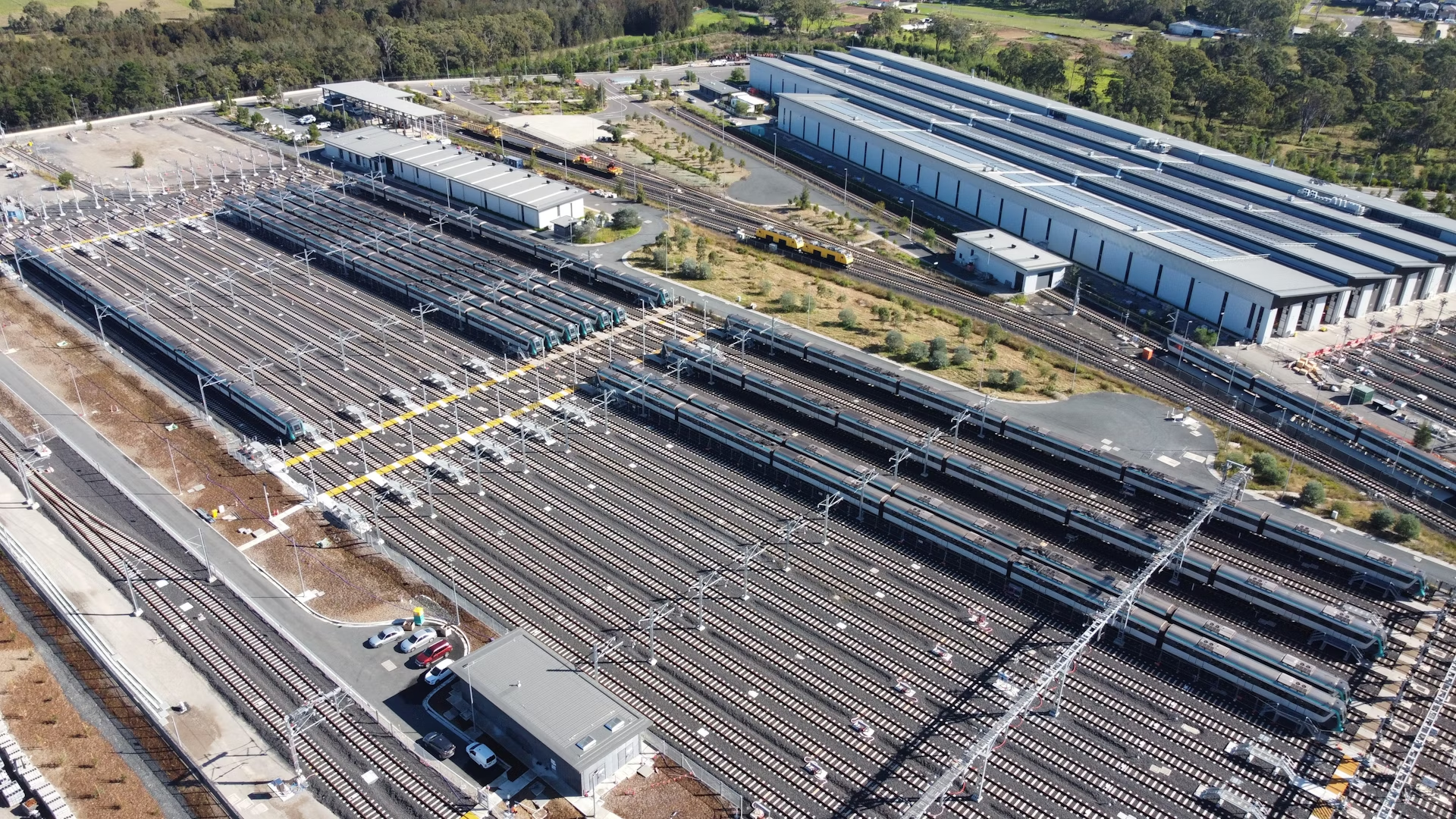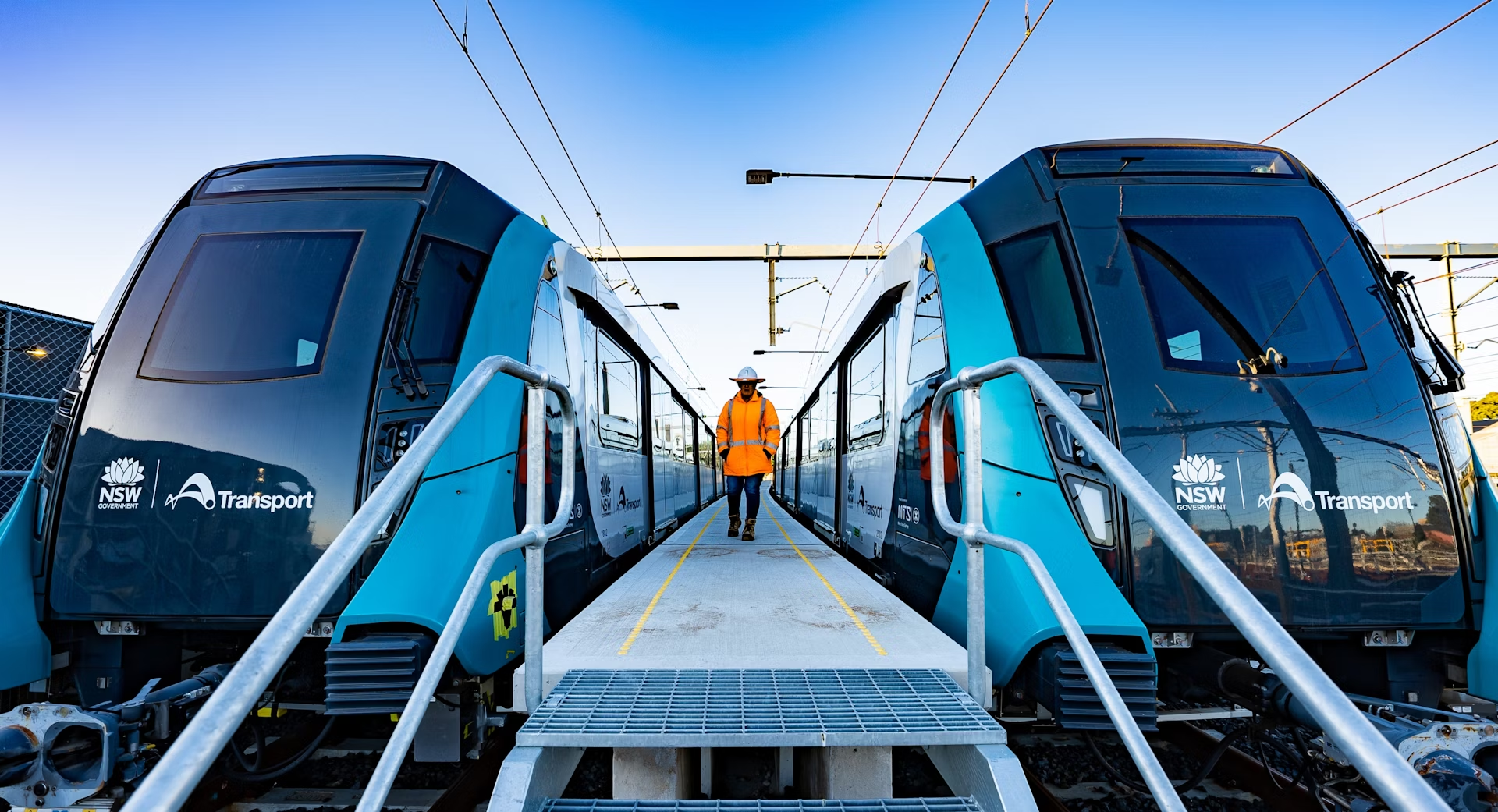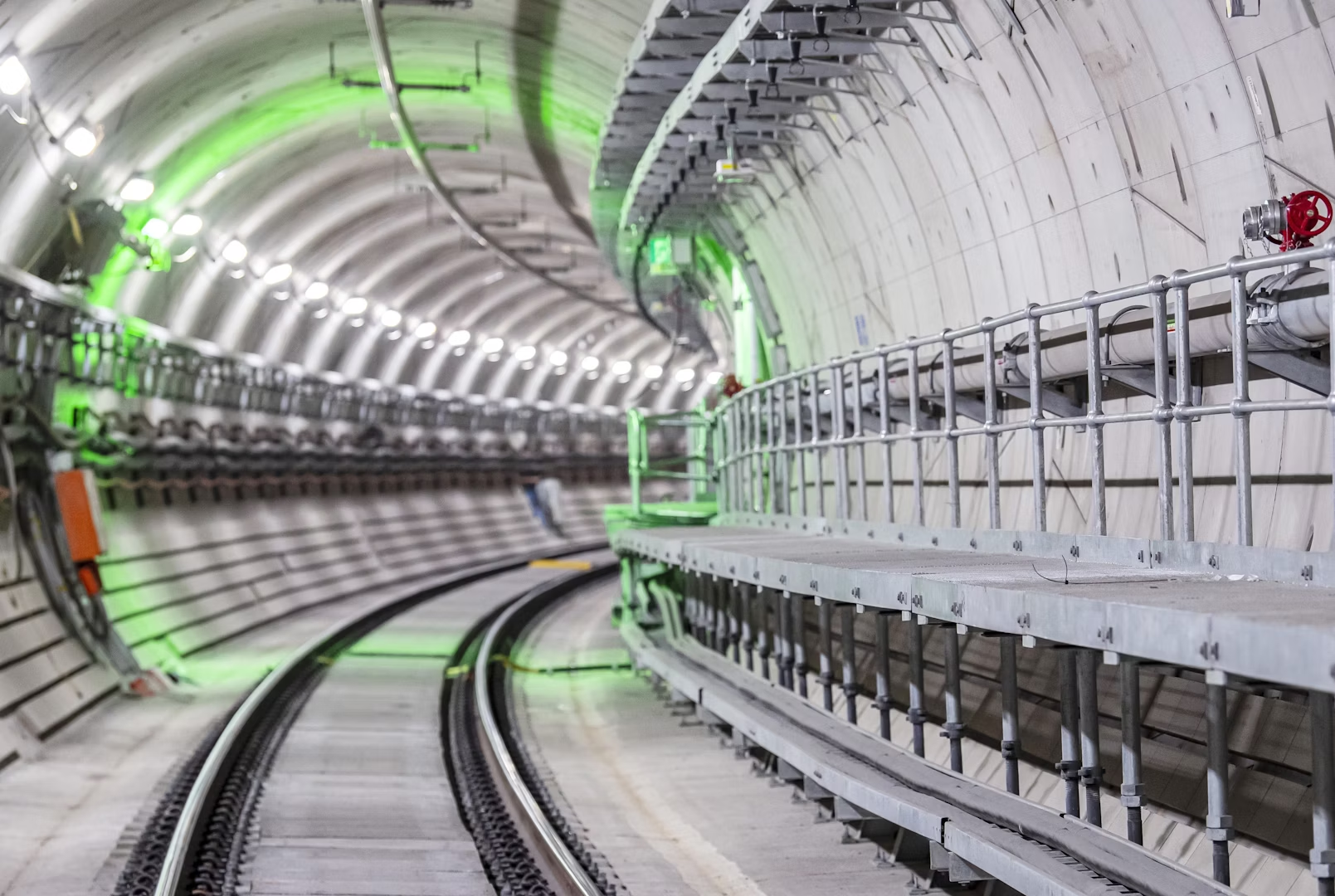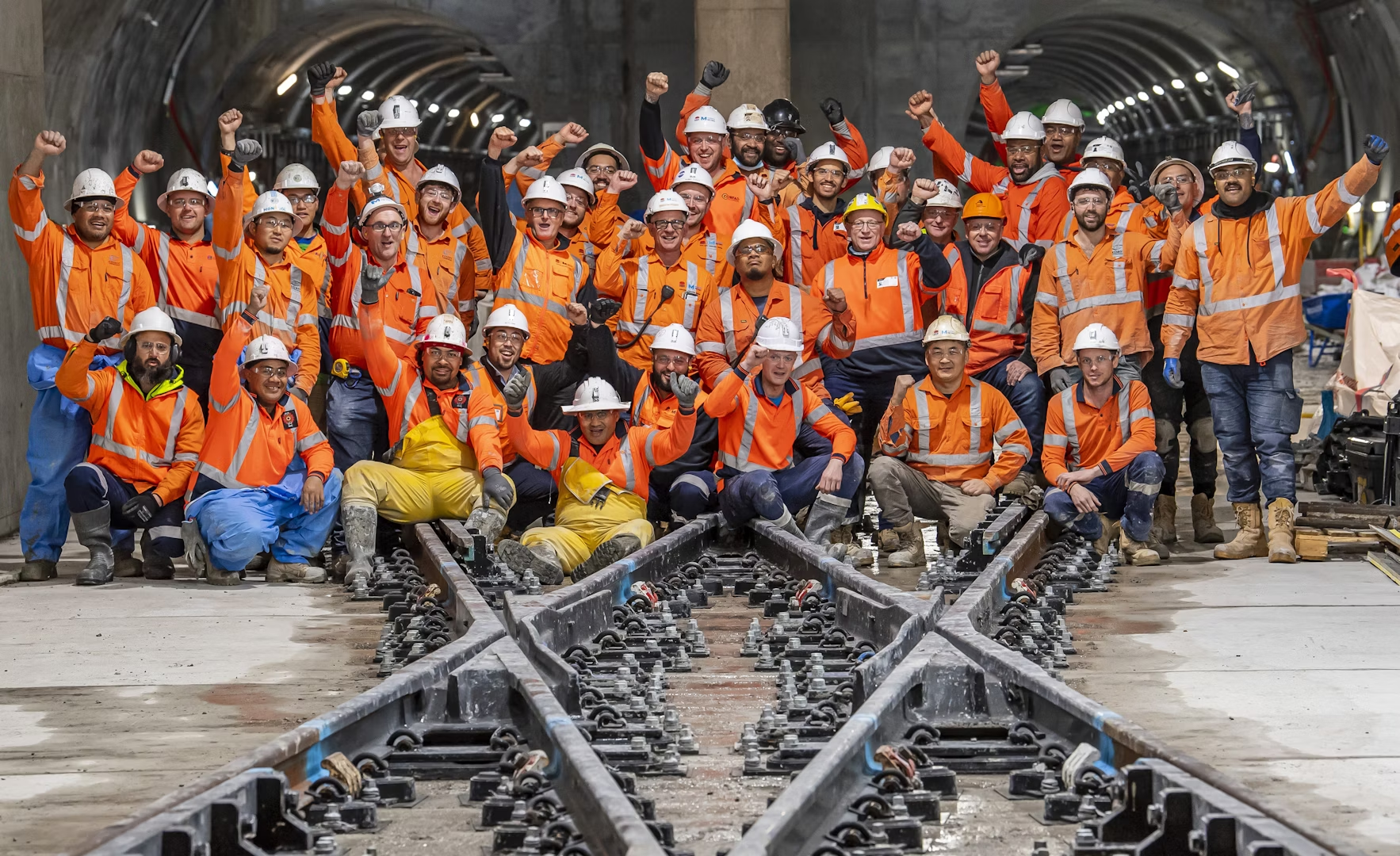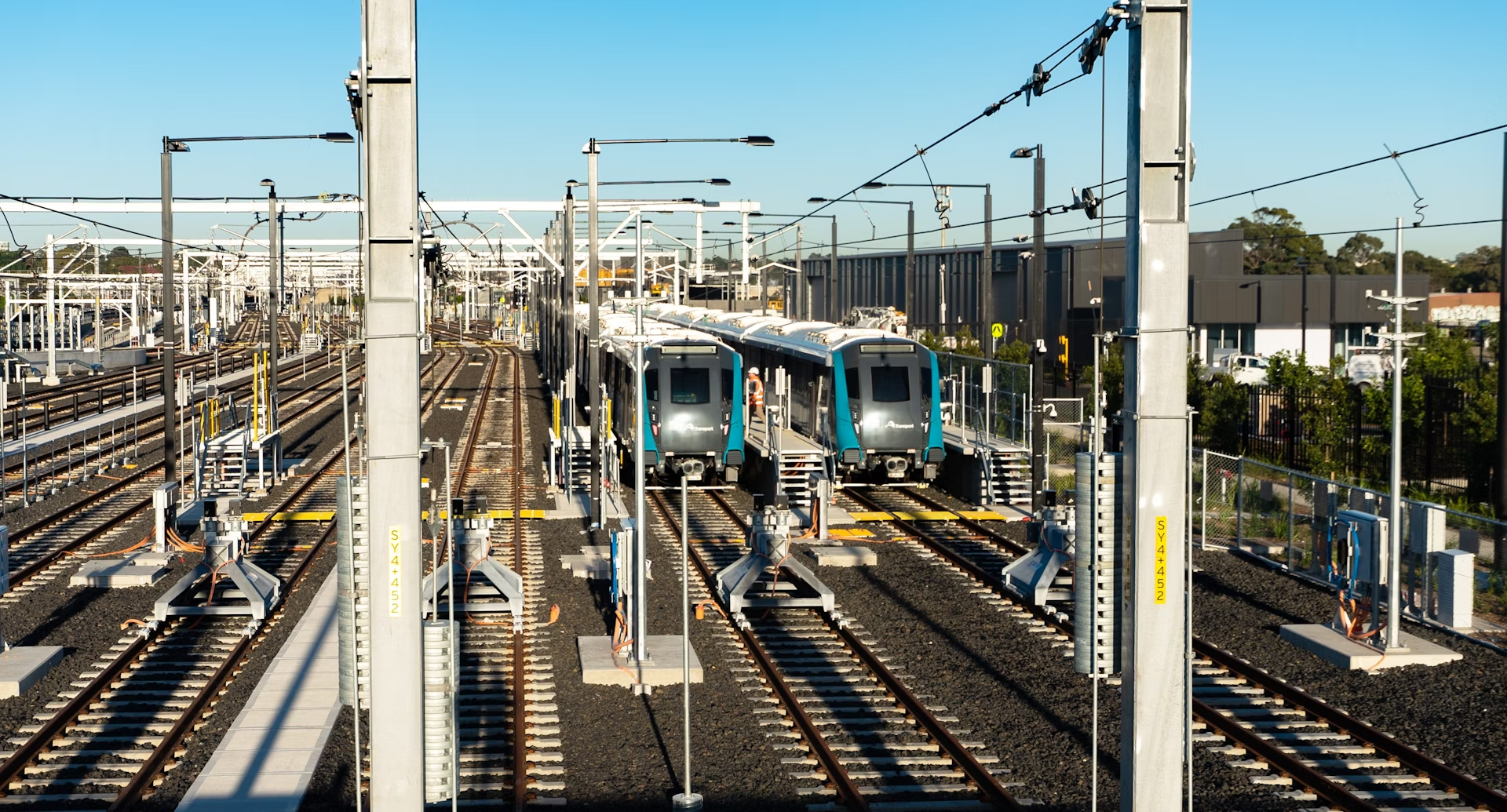Sydney Metro City & SW – Line-wide Works – Outstanding Achievement
Sydney Metro City & Southwest (SMCSW) is a key component of Sydney Metro, Australia’s biggest transport project. The extensive Line-wide Works package delivered by Systems Connect, a joint venture of CPB Contractors and UGL Limited, included installation of 31 km of underground railway track, power equipment, cabling, ventilation, drainage and monitoring equipment, as well as constructing and expanding train stabling and maintenance facilities and fitting out substations in train stations.
Outstanding collaboration with Sydney Metro and 28 delivery partners enabled a culture of innovation and delivery excellence and sustainable outcome. The team overcame challenges and developed innovative program and methodology solutions for a safe, sustainable, on-time delivery. Innovations and leading practices – including low-carbon concrete and synthetic fibre reinforcements, geopolymer sleepers, recycled crushed glass, circular solutions for reuse of water, sustainable procurement, and social sustainability initiatives – set new industry benchmarks for delivering sustainable future-ready metro rail projects.
Describe WHAT you have done and HOW you have done it. Please provide a summary of your initiative, innovation, or approach.
Systems Connect’s Line-wide Works (SCLWW) package is a major component of Sydney Metro City & Southwest (SMCSW) project. It involved a wide range of engineering design components consisting of tunnel permanent way, overhead lines and services fit-out, train maintenance and services buildings, ground water treatment plant, and multiple traction substations with HV Bulk-power supply (BPS) routes along the alignment.
A strong SMCSW Sustainability Strategy was established at the outset, setting out objectives and requirements with clear expectations for driving sustainability outcomes, including KPIs and incentives aimed at enhancing performance and innovation. A Sustainability Management Plan was established shortly after contract award, setting out a process to integrate sustainability into design, procurement and construction. A series of Sustainability, Innovation and Climate Change Risk workshops were held during the early design phase, to identify and embed sustainability and climate resilience outcomes into the design, procurement and construction processes. SCLWW Sustainability team worked collaboratively with the design, procurement and all construction teams across the project to ensure that Sydney Metro requirements and initiatives were delivered.
To facilitate effective identification and delivery of sustainable innovations and improvements early in the design phase, SCLWW had established the Continual Improvement Working Group (CIWG). The Group comprised representatives from all disciplines and Project areas to generate innovative design ideas, reviewed at the monthly CIWG meetings.
The CIWG approach involved the individual who raised an idea (the owner) being responsible for implementing the initiative into their respective design package. Progress was recorded and discussed at each meeting using the Improvements and Innovations Register. Where an idea was selected for further investigation, the owner prepared a brief proposal summarising the benefits/impacts on multiple factors: project program, whole-of-life cost, superior technical or improved functionality or operational characteristics, delivery or operational risk/s, impacts to environmental and/or community. The proposals were reviewed by the project’s subject matter experts and Senior Leadership Team before receiving endorsement.
SCLWW also encouraged active participation in raising sustainability ideas with: reward and recognition programs such as the monthly ‘Da Vinci Award’ recognising sustained efforts towards driving innovation, physical presence (toolbox talks and presentations, monthly innovation news, on-site and in-office marketing and promotional collateral) and digital presence (intranet containing a dedicated live innovation register accessible to all staff, including idea submission forms, and record of Da Vinci Winners ‘hall of fame’).
Prioritising innovation, SCLWW successfully delivered a range of sustainable outcomes through early design implementation of opportunities that encompass all fronts of sustainable design. A new benchmark for delivering future-ready metro rail projects was set by incorporating: 1) low-carbon solutions through sustainable material selection and reduction in materials by design optimisations, 2) reduction in energy and water operational footprints, and 3) social sustainability initiatives, all of which leave a legacy for the community with both environmental and social benefits.
What were the OUTCOMES and how were those outcomes shared?
Key outcomes include: 1) Embodied Carbon Reduction 2) Energy and water operational footprint reductions, and 3) Community benefits with social sustainability initiatives.
(1) Embodied Carbon Reduction
SCLWW achieved 27% reduction in greenhouse-gas (GHG) emissions and 15% reduction in Enviro-Points for the Mat-1 credit in the Design submission. This calculation was revised in the As-Built submission based on actual construction data and allowed the reductions from each initiative to be accurately measured, leading to verified GHG reduction of 36% and Enviro-Points reduction of 19.4%. Notable materials-related initiatives include:
- Low Carbon Concrete
SCLWW procured low-carbon concrete mix with alternatives to emission-intensive Portland cement, including Boral’s ‘Low Carbon High Performance’ ENVISIA® which has 50% ground granulated blast-furnace slag as its supplementary cementitious material (SCM). In total, SCLWW used approximately 73,000m3 of ready-mix concrete with around 47% SCM replacement, reducing embodied carbon by more than 24,000 tCO2e (~70% less) compared to BAU. - Fibre Reinforced Trackslab
Around 1,900 tonnes of reinforcing steel in the tunnel trackslab construction were replaced by a polymer fibre reinforcement product, BarChip (approx. 200 tonnes), reducing the embodied carbon by at least 3,000 tCO2e (44% less). - Geopolymer concrete sleepers Trial
Geopolymer concrete sleepers have approx. 57% lower emissions than those with conventional levels of Portland cement, with equivalent durability and strength, reduced shrinkage, and greater resistance to chlorides, acids, salts and fire. This successful trial at Sydney Metro Trains Facility (SMTF) South in Marrickville was verified as an ‘Australian First’, demonstrating the opportunity for wider geopolymer sleeper use in rail projects. - Recycled crushed glass
SCLWW procured approximately 1,000 tonnes of recycled crushed glass sand from a NSW-based provider for bedding/haunch/side overlay material in the track drainage material at SMTF stabling yard expansion in rouse Hill, replacing virgin-sand which reduced emissions-intensive haulage and avoided the environmental impacts of sandmining. SCLWW procured Pyrotek’s noise panels along the twin 15.5km tunnels, made of recycled crushed glass instead of the conventional cement material. - Local Procurement
Transport of heavy materials is a significant contributor to embodied carbon footprint particularly when imported from overseas. 75% of all steel was sourced locally in Australia, including steel used for rail, reinforcement bar and mesh, cable containments, roofing and portions of structural steels. Further, around 37,000 precast sleepers used for the length of the twin tunnels were procured from Austrak (manufactured in Wagga Wagga), significantly reducing transportation emissions compared to BAU assumption of overseas procurement.
(2) Energy and water operational footprints reduction
SCLWW achieved 99.8% reduction in energy compared to base case footprint across construction and 100 years of operation in the Design submission. Initiatives include offsetting 25% of construction electricity with Green Power and ACCUs, implementation of energy efficient design including 250kWp PV system at SMTF-S, and primarily Sydney Metro’s renewable energy offset commitment during operations.
SCLWW achieved around 75% reduction in water demand in Design submission compared to base case footprint where key measures included implementation of water efficient fittings/fixtures and planting drought-tolerant native vegetation, significantly reducing irrigation water demand.
SCLWW achieved around 80% replacement of potable water demand with non-potable sources across construction and 100 years of operation, where recycled water network and stormwater collected in sediment basins were used during construction, and amenities/washdown/cleaning water demand is supplied from a rainwater tank. The Ground Water Treatment Plant (GWTP)’s treated water tops-up the rainwater system, and the treated water is reused for daily GWTP filter backwash, a large contributor to the water footprint.
(3) Community Benefits with social sustainability initiatives
Social sustainability initiatives delivered tangible benefits to local communities, including:
- supporting Dignity’s ‘Ready to Work Program’ with funding to increase housing security and employment prospects for 22 homeless individuals
- developing a volunteering program where 60 SCLWW employees spent 300 hours to assemble essentials for the homeless including food
- leading a clothing drive in collaboration with delivery partners to support disadvantaged women, homeless individuals and vulnerable Indigenous communities
- funding The Salvation Army’s Graceville Women’s Refuge to provide emergency accommodation, essential kits for mothers and children, stationery supplies, and counselling sessions.
SCLWW promoted local heritage values by implementing heritage interpretations at Blues Point with interpretive signs referencing Aboriginal land and local history, and at Marrickville with a planned artwork featuring indigenous and non-indigenous elements.
Describe WHO benefited from your initiative, innovation, or approach?
Establishing an industry benchmark
Through the abovementioned design initiatives, SCLWW established a new industry benchmark for future rail projects in reducing embodied carbon, energy and water footprints.
For example, a geopolymer sleeper innovation trial demonstrates the availability of this sustainability technology to the wider rail construction industry which can reduce emission by approximately 57%. Success of this trial shows the potential for wider implementation of this technology which aligns with Transport NSW (TfNSW)’s Recycled and Reused Material Opportunities in Rail Projects visual guide, which states that geopolymer mix in concrete applications is an innovation that must be considered.
Additionally, the reuse of recycled crushed glass on the project outlines the potential for its wider application and adoption as a business-as-usual practice. Recycled crushed glass is a readily available material that can be used as an alternative to natural sand excavated from seashores, whilst rendering large environmental impact (IS EnviroPoints) reductions. Similarly to the geopolymer sleepers, this initiative also aligns with the TfNSW guide’s innovation recommendations.
Social and Workforce Development and Industry Participation (WDIP) Benefits
SCLWW partnered with ‘Mates on the Move’ (Social Traders Certified), a social enterprise providing waste management services to Sydney businesses to create employment and career opportunities for people leaving prison. This initiative was adopted by the North Sydney office where used coffee cups and papers towels were collected by former inmates, providing them with employment opportunities and contributed to office waste targets.
To improve SCLWW’s WDIP outcomes, the project engaged 146 Australian and New Zealand small-medium-enterprises in its supply chain (where at least 20 was the target), of which 125 were local, and 30 ANZ SMEs that are recognised Aboriginal businesses (where at least 10 was the target). SCLWW’s Aboriginal participation spend exceeded its target by over $5 million.
As part of a commitment to provide training and development opportunities for communities along the SMCSW alignment, 82 refugees and asylum seekers were employed by the project. The project benefitted from CPB partnership with CareerSeekers to provide employment opportunities for the refugee community.
Across all SMCSW Projects, 80 returned servicemen have been employed to date, with 15 hired directly by SCLWW.
The project also delivered above it’s 8% target of employing Women in non-traditional trades and occupants of which women comprised 8.1% of the workforce.
What LEGACY and UN SDG CONTRIBUTION was achieved?
Goal 11 SUSTAINABLE CITIES & COMMUNITIES – “make cities and human settlements inclusive, safe, resilient and sustainable”.
The City component of Sydney Metro City & Southwest (SMCSW) opened in August 2024 between Chatswood and Sydenham with 6 new metro stations, new metro platforms at Central and Sydenham, and twin 15.5 km rail tunnels (SCLWW’s scope), and will be extended in 2025 between Sydenham and Bankstown with 11 stations upgraded to metro standards. SMCSW will provide customers with fast, reliable turn-up-and-go rail services and fully accessible stations on Australia’s only driverless rapid metro system. With Greater Sydney’s population expected to grow by around 1 million more people by 2034, improved rail infrastructure will be critical to support this growth and create a connected, livable, accessible and sustainable Sydney with a thriving economy. Through delivery excellence and a positive culture of collaboration and innovation, the SCLWW is supporting the timely and safe opening to the public of a world-class railway for Sydney, setting high benchmarks for the industry, and leaving a positive, sustainable legacy for Australian industries and communities.
GOAL 6 CLEAN WATER AND SANITATION - “Ensure availability and sustainability management water and sanitation for all”.
The permanent groundwater treatment plant (GWTP) at SMTF South in Marrickville captures stormwater and groundwater seepage from the underground tunnels. Instead of discharging directly to downstream (Cooks River), the system is designed to ensure water is first treated to a level that will contribute to achieving the Cook’s River’s water quality improvement objectives. Prior to discharge, the system is designed to reuse its own treated water for filtration back-wash, and for supply to the onsite rainwater tank which is reticulated for irrigation, train washdown and office amenities. This significantly reduces the potable water demand and associated environmental impacts. SCLWW further reduced water demand by installing improved WELS-rated fixtures/fittings at all service buildings and planting drought-tolerant landscaping. Overall, water harvesting and recycling will render the Marrickville trains facility 100% self-sufficient for all non-drinking water needs.
GOAL 8 DECENT WORK AND ECONOMIC GROWTH - “Promote sustained, inclusive and sustainable economic growth, full and productive employment and decent work for all”.
SCLWW’s social sustainability initiatives supporting and engaging in partnerships with multiple charitable organisations successfully provided tangible benefits to local community groups that promote economic growth and employment for the vulnerable members of the community. In improving the Project’s WDIP outcomes, SCLWW engaged 146 local SMEs in its supply chain, exceeded the Aboriginal participation and women in non-traditional roles targets, and employed refugees/asylum seekers and returned service personnel, providing them with employment opportunities. These socio-economic benefits promote sustainable economic growth and a range of employment opportunities, supporting some of the most vulnerable community groups.
GOAL 9 INDUSTRY, INNOVATION AND INFRASTRUCTURE - “Build resilient infrastructure, promote inclusive and sustainable industrialisation and foster innovation”.
The success of this project demanded high-level leadership, collaboration, problem solving and innovation from the outset, achieved by maintaining flexibility and careful management of complex interfaces as SCLWW collaborated with Sydney Metro and 28 delivery partners to develop an innovative program and methodology solutions that facilitated or accelerated the project’s momentum. The CIWG embedded innovation into the Project’s culture and contracts. By prioritising the identification, consideration, and adoption of innovations, providing benefits for delivery partners, efficiency gains and efficiencies in construction and reductions of embodied carbon, energy and water demands. This was key in driving innovative and agile solutions that contributed significantly to the success of the SCLWW Project. By pioneering new techniques, lifting sustainability standards, and setting new industry benchmarks, this Project paved the way for future rail and metro projects to be more efficient and sustainable.


